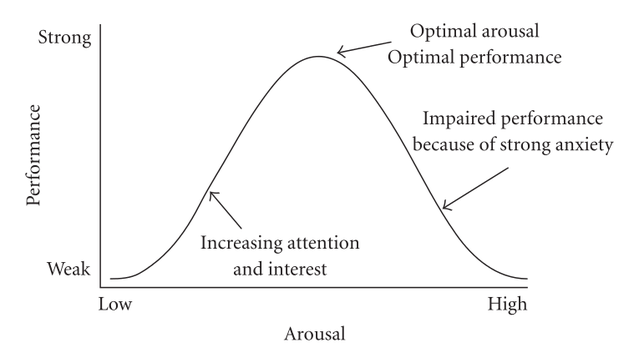[Article updated on 17 September 2017]
On October 30, 1938 Orson Welles broadcast an episode of the American radio drama Mercury Theatre on the Air. This episode, entitled The War of the Worlds, was based on a novel by HG Wells (1866–1946) and suggested to listeners that a Martian invasion was taking place. In the tense atmosphere of the days leading up to the Second World War, many people missed or ignored the opening credits and took the radio drama to be a genuine news broadcast. Panic ensued as they began to flee, with some even reporting that they could see flashes of light in the distance and smell poison gas. This panic, a form of mass hysteria, is one of many forms that anxiety can take. But what is anxiety, why does it exist, and when does it become a problem?

Definition of anxiety
According to its medical definition, anxiety is a state consisting of psychological and physical symptoms brought about by a sense of apprehension at a perceived threat. These psychological and physical symptoms vary greatly according to the nature and magnitude of the perceived threat, and from one person to another.
Symptoms of anxiety
Psychological symptoms may include feelings of fear, an exaggerated startle reflex or alarm reaction, poor concentration, irritability, and insomnia. In mild anxiety physical symptoms arise from the body’s so-called fight-or-flight response, a state of high arousal that results from a surge of adrenaline. These physical symptoms include tremor, sweating, muscle tension, a fast heartbeat, and fast breathing. Sometimes people can also develop a dry mouth and the irritating feeling of having a lump in the throat. This feeling, referred to in the medical jargon as 'globus hystericus’, leads to forced swallowing and a characteristic gulping sound that is often exploited in children’s cartoons to signal fear.
In severe anxiety, hyperventilation or over-breathing can lead to a fall in the concentration of carbon dioxide in the blood. This gives rise to an additional set of physical symptoms including chest discomfort, numbness or tingling in the hands and feet, dizziness, and faintness. It is not unheard of for children to play a dangerous game in which they hyperventilate and then perform the Valsalva manoeuvre to make themselves faint. The Valsalva manoeuvre involves putting the thumb in the mouth and blowing hard against it without letting any air out. This increases the pressure inside the chest, impeding the return of venous blood to the heart and resulting in a rapid drop in blood pressure.
Uses of anxiety
Anxiety is a normal response to life experiences, a protective mechanism that has evolved both to prevent us from entering into potentially dangerous situations and to enable us to escape from them should they befall us regardless. For example, anxiety may prevent us from coming into close contact with disease-carrying or poisonous animals such as rats, snakes and spiders; from engaging with a much stronger enemy to whom we are almost sure to lose out; and even from declaring our undying love to someone who is unlikely to spare our feelings.
If we do find ourselves in a potentially dangerous situation, the fight-or-flight response brought on by anxiety may help us to mount an appropriate response by priming our body for action and increasing our performance and stamina.
The Yerkes-Dodson curve

Although some degree of anxiety can improve our performance on a range of tasks, severe anxiety can have the opposite effect and hinder our performance. Thus, whereas a confident and talented actor may perform optimally in front of a live audience, a novice may develop stage-fright and freeze. The relationship between anxiety and performance can be expressed graphically by a parabola or inverted ‘U’. This is referred to as the Yerkes–Dodson curve, after the psychologists RM Yerkes and JD Dodson.
According to the Yerkes–Dodson curve our performance increases with arousal but only up to a certain point, beyond which our performance begins to flag. The Yerkes–Dodson curve applies best to complex or difficult tasks, rather than to simple tasks on which the relationship between arousal and performance is more linear. The nature of the task is also important. Generally speaking, intellectually demanding tasks require a lower level of arousal for optimal performance. In contrast, tasks that call for strength and stamina require a higher level of arousal for optimal performance. This makes perfect sense given that the potentially dangerous situations that trigger a high level of anxiety are typically those that call for strength and stamina, for example, to face a foe or scamper up the nearest tree.
In closing
The Yerkes–Dodson curve suggests that very high anxiety can be more of a hindrance than a help. From a medical stand-point, anxiety is considered to be problematic if it becomes so severe, frequent, or longstanding that it prevents a person from fulfilling his occupational or social obligations. Such anxiety often results from an anxiety disorder, although in some instances it can also result from a number of psychiatric and medical disorders such as depression, schizophrenia, alcohol withdrawal, or an overactive thyroid gland.
Anxiety disorders are very common and affect about one in every five people. They present in a number of forms, including phobic anxiety disorders, panic disorder, generalized anxiety disorder, conversion disorders, post-traumatic stress-disorder, and culture-bound syndromes.
More on these to follow soon.
Neel Burton is author of Growing from Depression, Heaven and Hell: The Psychology of the Emotions, and other books.




